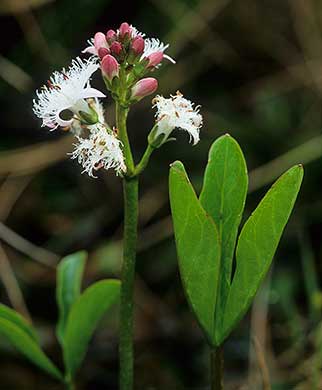Bogbean (Menyanthes trifoliate)
When: May - June
How many: Relatively widespread, in large numbers sometimes

The bogbean, an aquatic perennial, is surely one of the most exotic blooms to be found in the New Forest, more akin to a plant of faraway places than one of central southern England. It is perhaps fortunate, then, that bogbeans usually grow in wet, relatively inaccessible places where not too many people are tempted to pick the flowers.
It's said that the bogbean gets part of its name from the triple cluster of leaves that recall those of broad beans. The 'bog' element of the name, though, is something of a misnomer, for whilst bogbeans can certainly be found in New Forest bogs, they’re more prevalent in the standing water of the area’s shallow pools where they sometimes form impressive sheets of densely clustered stems.
(John Wise, writing in the mid-19th century, described bogbeans as ‘Common in most of the New Forest pools on the south’).
Pinkish crimson when in bud; white, pink-tinged bogbean flowers appear in May and June. They’re star shaped, five-petalled and fringed with extravagant white, cottony hairs.
In the late 16th century, John Gerard wrote of bogbean flowers, saying: ‘Towards the top of the stalks standeth a bush of feather-like flowers of a white colour, dasht over slightly with a wash of light carnation.’
To help maximise the likelihood of cross-pollination between bogbeans, two types of flower are found, with usually only one type present per plant. Each has slightly differently arranged pollination parts, so that visiting insects pick-up pollen from one type, but are more likely to deposit it on the other.
Then, as a fail-safe to guard against an absence of cross-pollinating insects, provision is also made for self-pollination through smaller, non-opening flowers that have no option but to self-pollinate as insects have no effective access to the pollen.
Sturdy, upright bogbean stems and luxuriant trefoil leaves on long stalks are invariably raised well above the water’s surface, often to a height of 30 centimetres (12 inches), or more.
Bogbean seeds eventually disperse in the water, remaining viable for many months whilst afloat within their egg-shaped capsules. But out of sight, in the water’s depths, the bogbean’s creeping underwater rhizome also spreads vegetatively, providing alternative propagation opportunities.
Alternative country names are buck bean and marsh trefoil, the latter surely as appropriate as bog bean.
Bogbeans have been put to many uses. Bogbean rhizomes were sometimes used medicinally, whilst the leaves were added to beer to impart a bitter taste, as well as being used as a treatment for rheumatism and a cure for scurvy. Not even the seeds went to waste – they were used as a remedy for coughs and colds.
Indeed, herbalists still use bogbean leaves, gathered just after the flowering period, to encourage appetite and stimulate digestion, whilst in the past, large doses have been found to be an effective laxative!
References:
The Flora of Hampshire: Anne Brewis, Paul Bowman and Francis Rose
The Wild Flowers of Britain and Northern Europe: Richard Fitter, Alastair Fitter and Marjorie Blamey
Collins New Generation Guide - Wild Flowers of Britain and Northern Europe: Alastair Fitter
Reader’s Digest Field Guide to the Wild Flowers of Britain
The Encyclopedia of British Wild Flowers: John Akeroyd
The Herball or General Historie of Plantes: John Gerard
The New Forest: Its History and Scenery: John R. Wise
Oxford Dictionary of Plant-lore: Roy Vickery
More links
Other related links
Search this site

Sadly, 58 animals were killed - 35 ponies, 13 cows, 8 donkeys and 2 sheep, whilst a further 32 were injured - 3 pigs, 9 donkeys, 11 cows and 9 ponies.
(Forty-three accidents occurred in daylight, 15 at twilight and 101 in the dark. Twenty-seven accidents were not reported by the driver involved).
Here's just one horrific example - Three donkeys killed in collision with van at notorious New Forest blackspot (Advertiser and Times)

